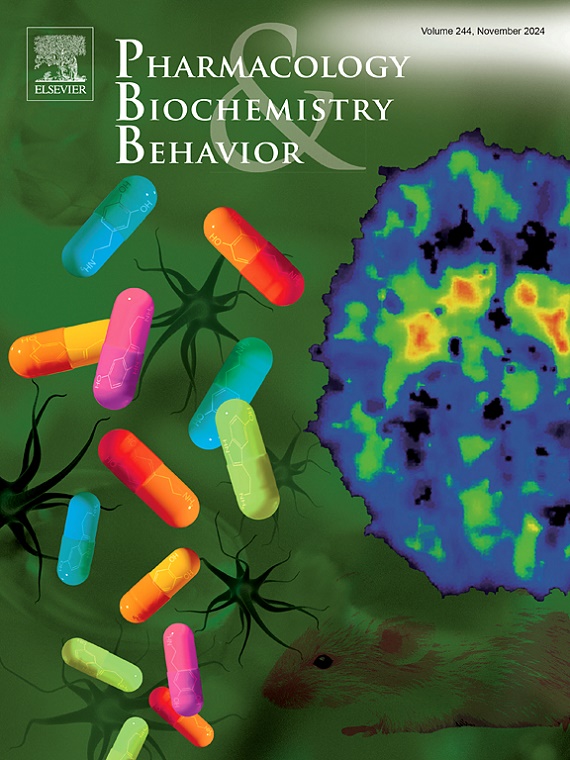乙二醛酶-1 (GLO1)的药理学和遗传学操作不会改变可卡因或羟考酮诱导的运动反应或条件位置偏好。
IF 3.3
3区 心理学
Q1 BEHAVIORAL SCIENCES
引用次数: 0
摘要
甲基乙二醛(MG)是糖酵解的内源性非酶副产物,作为GABAA受体的部分激动剂。MG由乙二醛酶-1 (GLO1)代谢。抑制GLO1增加甲基乙二醛水平,并已被证明可以调节多种行为,包括减少寻求可卡因配对线索和乙醇消耗。这些研究的目的是确定GLO1的操纵是否可以改变可卡因或羟考酮诱导的运动激活和/或对可卡因或羟考酮的条件性位置偏好(CPP)。我们使用GLO1的药理学和遗传学操作来解决这个问题。GLO1抑制剂s-溴苄基谷胱甘肽环戊二酯(pBBG)的使用没有改变对可卡因或羟考酮的运动反应。此外,pBBG对可卡因或羟考酮的位置偏好没有显著影响。基因敲除Glo1在概念上类似于药物抑制,对可卡因的CPP没有任何显著影响。最后,Glo1过表达不影响对可卡因的运动反应。总之,我们的结果没有显示GLO1的药理学或遗传操作对可卡因或羟考酮的运动反应或CPP有任何影响。本文章由计算机程序翻译,如有差异,请以英文原文为准。
Pharmacological and genetic manipulation of glyoxalase-1 (GLO1) does not alter locomotor responses or conditioned place preference induced by cocaine or oxycodone.
Methylglyoxal (MG) is an endogenously produced non-enzymatic side product of glycolysis that acts as a partial agonist at GABAA receptors. MG is metabolized by the enzyme glyoxalase-1 (GLO1). Inhibition of GLO1 increases methylglyoxal levels, and has been shown to modulate various behaviors, including decreasing seeking of cocaine-paired cues and ethanol consumption. The goal of these studies was to determine whether manipulation of GLO1 could alter cocaine- or oxycodone-induced locomotor activation and/or conditioned place preference (CPP) to cocaine or oxycodone. We used both pharmacological and genetic manipulations of GLO1 to address this question. Administration of the GLO1 inhibitor s-bromobenzylglutathione cyclopentyl diester (pBBG) did not alter the locomotor response to cocaine or oxycodone. Additionally, pBBG had no significant effect on place preference for cocaine or oxycodone. Genetic knockdown of Glo1, which is conceptually similar to pharmacological inhibition, did not have any significant effects on CPP to cocaine. Finally, Glo1 overexpression did not affect locomotor response to cocaine. In summary, our results did not show any effect of pharmacological or genetic manipulations of GLO1 on the locomotor response or CPP to either cocaine or oxycodone.
求助全文
通过发布文献求助,成功后即可免费获取论文全文。
去求助
来源期刊
CiteScore
6.40
自引率
2.80%
发文量
122
审稿时长
38 days
期刊介绍:
Pharmacology Biochemistry & Behavior publishes original reports in the areas of pharmacology and biochemistry in which the primary emphasis and theoretical context are behavioral. Contributions may involve clinical, preclinical, or basic research. Purely biochemical or toxicology studies will not be published. Papers describing the behavioral effects of novel drugs in models of psychiatric, neurological and cognitive disorders, and central pain must include a positive control unless the paper is on a disease where such a drug is not available yet. Papers focusing on physiological processes (e.g., peripheral pain mechanisms, body temperature regulation, seizure activity) are not accepted as we would like to retain the focus of Pharmacology Biochemistry & Behavior on behavior and its interaction with the biochemistry and neurochemistry of the central nervous system. Papers describing the effects of plant materials are generally not considered, unless the active ingredients are studied, the extraction method is well described, the doses tested are known, and clear and definite experimental evidence on the mechanism of action of the active ingredients is provided.

 求助内容:
求助内容: 应助结果提醒方式:
应助结果提醒方式:


